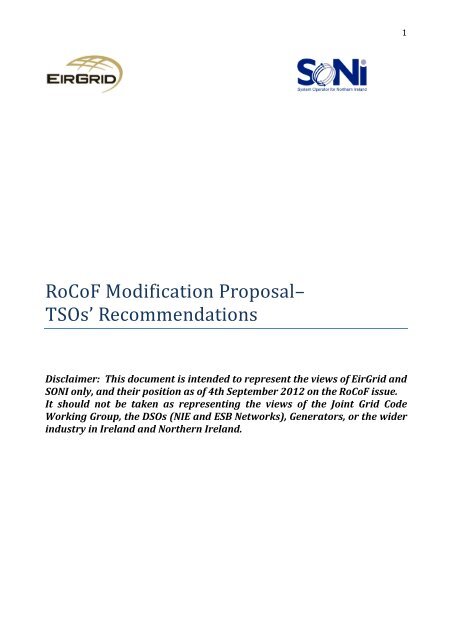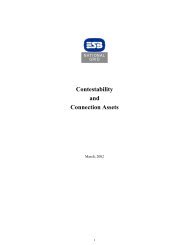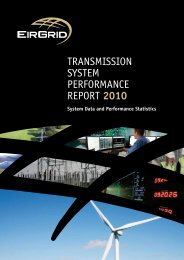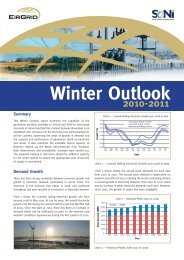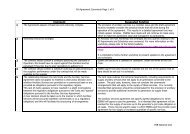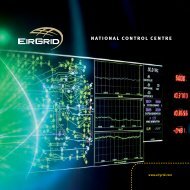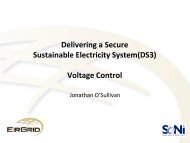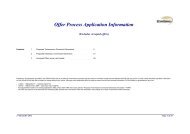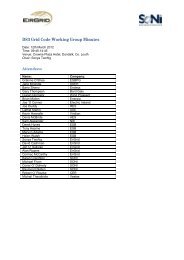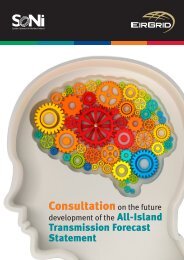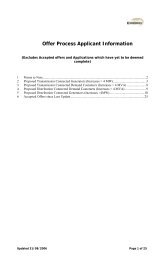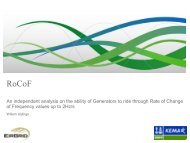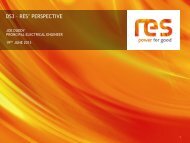RoCoF Modification Proposalâ TSOs' Recommendations - Eirgrid
RoCoF Modification Proposalâ TSOs' Recommendations - Eirgrid
RoCoF Modification Proposalâ TSOs' Recommendations - Eirgrid
Create successful ePaper yourself
Turn your PDF publications into a flip-book with our unique Google optimized e-Paper software.
1<strong>RoCoF</strong> <strong>Modification</strong> Proposal–TSOs’ <strong>Recommendations</strong>Disclaimer: This document is intended to represent the views of EirGrid andSONI only, and their position as of 4th September 2012 on the <strong>RoCoF</strong> issue.It should not be taken as representing the views of the Joint Grid CodeWorking Group, the DSOs (NIE and ESB Networks), Generators, or the widerindustry in Ireland and Northern Ireland.
2Introduction and ContextThe purpose of this document is to give some background and contextual information toassist the Regulatory Authorities as they consider the proposed Rate of Change of Frequency(<strong>RoCoF</strong>) modification and associated issues.The Irish Government has set a target of 40% of electricity to come from renewablegeneration by 2020 [1]. Northern Ireland has set a similar target [2]. The vast majority ofthis electrical energy is expected to come from wind turbines. In order to achieve the 40%target, the instantaneous amount of wind on the system will have to far exceed 40% at timesbecause wind is an intermittent resource. For various technical reasons, there are limits tohow much wind can be accommodated on a power system. These limits will determine thelevel of curtailment experienced by windfarms, and have a knock-on impact on the viabilityand bankability of windfarm projects, and thus on the likelihood of the Government targetsbeing achieved. The TSOs (EirGrid and SONI) launched the DS3 Programme (Delivering aSecure and Sustainable Electricity System) in 2011 in order to address these technicalconstraints on the maximum allowable wind penetration. The Grid Code and <strong>RoCoF</strong>Workstreams in the DS3 programme aim to specifically address the issues around thecurrent operational limits on wind generation, and are doing so with cross-industryparticipation in a joint grid code working group, an industry advisory council, and throughTSO-DSO meetings and bilateral discussions.The impact of high levels of wind generation has been studied in various different ways overthe past few years [3]. The “Facilitation of Renewables” (FoR) study, which was published in2010, was a detailed technical study that considered levels of non-synchronous generation(wind and HVDC imports) up to 100% of system demand. The studies covered a variety ofissues related to power system operation including fault levels, small-signal stability,frequency response, transient stability, as well as potential mitigation measures to help solveany problems encountered. It was based on an assumed 2020 network, with the technicalanalysis being carried out by Siemens and ECAR consultants. The final report was drafted byEcofys, and the study was peer-reviewed [4].The main outcome of the study was that wind levels (non-synchronous generation) up toabout 75% of demand could be accommodated, but a series of mitigation measures wouldhave to be carried out. Beyond 75% with current technology it would not be prudent tooperate the power system of Ireland and Northern Ireland. One of the main mitigationmeasures was to address the issue of <strong>RoCoF</strong>. This issue is the current binding limitation onoperating the power system past a system non-synchronous penetration (SNSP) of 50%.The modification being sought on <strong>RoCoF</strong> is the first step in enabling the TSOs to operate thesystem with higher levels of wind, helping both Ireland and Northern Ireland to achieve theirrenewable energy targets. If approved, a series of other steps will then be required,including testing of generators and resolution of the loss-of-mains issue on the distributionnetworks. Improved windfarm standards will also be required in the future. But the <strong>RoCoF</strong>problem is one of the main hurdles that need to be overcome; otherwise the TSOs’ policieson allowable non-synchronous penetration levels will not change.
3The <strong>RoCoF</strong> ProblemThe nominal system frequency is 50Hz. This is maintained by the synchronous machines onthe system adjusting their power output so that supply and demand remains in balance. Therotational inertia of the machines tends to keep the frequency steady, though somefluctuation in frequency is allowed and expected. When a generator trips off the system,there is an instantaneous energy imbalance in the system. The speed of the synchronousrotating machines reduces to maintain the energy balance, resulting in a decrease infrequency. The rate of change of frequency is a measure of how rapidly the speed of themachines, and thus the system frequency, slows down. The FoR study found that for the lossof the largest generator on the system, <strong>RoCoF</strong> values in excess of 0.5Hz/s could occur.Separately, the FoR study found that if a fault led to a voltage dip, and this voltage dipaffected a cluster of windfarms, then much higher <strong>RoCoF</strong> values could be experienced. Theselarge <strong>RoCoF</strong> values (>1 Hz/s) were due to the significant energy imbalances caused by thewindfarms reducing their output for hundreds of milliseconds following such a faultclearance. This was estimated in the highest wind scenario to be up to 1400MW for a threephase fault on Tarbert-Prospect 220 kV cable. In turn, this significant energy imbalancecould adversely interact with other units that were incapable of riding through <strong>RoCoF</strong> inexcess of 0.5 Hz/s leading to a cascade collapse. However on this particular challenge Ecofysfound that additional investigations were required.In the Northern Ireland Grid Code there is no specific mention of <strong>RoCoF</strong>. SONI expectconventional generation to have the capability to continue operating through <strong>RoCoF</strong> valuesgreater than 1Hz/s. Historic <strong>RoCoF</strong> events have occurred in Northern Ireland that have beengreater than 1Hz/s with no sympathetic tripping from generators. Prior to new generationbeing connected in Northern Ireland, SONI provide a connectee with a Minimum FunctionalSpecification (MFS) which does include a <strong>RoCoF</strong> value of 1.5Hz/s. Since the year 2000, over1100MW of new generation has complied with an MFS [5]. However, the current <strong>RoCoF</strong>standard in Ireland as specified in the Grid Code is 0.5Hz/s: generators are obliged to staysynchronised for <strong>RoCoF</strong> values up to this level. Thus, it is conceivable that if the system wasoperated such that <strong>RoCoF</strong> values in excess of 0.5Hz/s could occur, then conventionalgenerators could cascade trip off the system, or argue that they were not designed to operatein such scenarios. It would not be prudent to operate the power system in this scenario.Therefore there is a need for generators to ensure they are capable of riding through <strong>RoCoF</strong>values in excess of 0.5Hz/s , but not exceeding 1Hz/s on the all-island system (or 2Hz/s inNorthern Ireland if they underwent a system separation event).A related problem is that the Distribution System Operators (DSO) employ or mandateprotection schemes for loss-of-mains protection. These schemes aim to ensure that should apart of the distribution network become islanded from the rest of the distribution system,that there is no generation left operating on that local system, keeping it live. This is prudentand in keeping with their duties to ensure a safe network. Currently ESB Networks and NIEemploy or mandate schemes that utilise under- and over-frequency relays as well as rate ofchange of frequency relays or vector-shift detection. The majority of embedded generatorsin Northern Ireland use vector-shift rather than <strong>RoCoF</strong>.Where <strong>RoCoF</strong> settings are used for loss-of-mains and they are set at levels which can beexperienced following the largest single credible contingency, then there is a risk of cascadetripping on the power system, potentially leading to a blackout.
4It needs to be made clear that the proposed Grid Code modifications on <strong>RoCoF</strong> are seeking acapability from generators and windfarms connected to either the transmission ordistribution network to ride through higher rates of change of frequency that result fromloss of generation events, whereas the DSOs need to specify a <strong>RoCoF</strong> threshold (which needsto be exceeded for a set period) that allows them to protect against generation islanding onthe distribution system(s). Thus, on the distribution system, distribution-connectedgenerators may be disconnected due to relay action as a result of high <strong>RoCoF</strong> values or as aresult of vector shifts. It is not the intention of the TSOs to dictate how loss-of-mainsprotection is implemented or what settings need to be applied – that is the DSOs role.However, the operational policies of the TSOs and the loss-of-mains protection settingsapplied by the DSOs will need to be co-ordinated as the levels of wind increase on the powersystem.ProcessFollowing the publication of the Facilitation of Renewables Study in April, 2010, EirGridformally wrote to all generators in Ireland (during Quarter 4, 2010) requesting confirmationof their technical capability with regard to <strong>RoCoF</strong>. The majority of the replies indicated thatthe generators were Grid Code compliant, but did not specify if they could withstand <strong>RoCoF</strong>values higher than 0.5Hz/s. EirGrid subsequently wrote to the generators again in early2011 seeking further information on the <strong>RoCoF</strong> capabilities of generators. The majority ofresponses did not clearly address the issue. It was decided that an alternative approach,using the Grid Code Review Panel as a forum, was required, as formal modification proposalsto the Grid Code would enable generators to formally respond on their capabilities.SONI carried out a similar exercise at the beginning of 2012. All generators that areconnected to the transmission system or have a Transmission Use of System Agreement(TUOSA) were contacted for information on their <strong>RoCoF</strong> capability. The main findings werethat that over 85% of connected wind generation use vector shift rather than <strong>RoCoF</strong>. Theresponses from conventional generators were not as comprehensive but generally statedthat the <strong>RoCoF</strong> capability would be in the region that is mentioned in the MinimumFunctional Specification (i.e. 1.5Hz/s). However, there were concerns on the effect ofincreased and more frequent high <strong>RoCoF</strong> events on the lifespan of the generators.An initial <strong>RoCoF</strong> Grid Code modification (MPID 219) was proposed at the Ireland Grid CodeReview Panel Meeting #29 on October 13, 2011. In this proposal, a change from 0.5Hz/s to4Hz/s was suggested. At this meeting, it was suggested by EirGrid that a working group beset up to allow cross-industry participation.The Joint Working Group involves participants from the TSOs, DSOs, Wind Industry andDevelopers, and Conventional Generators, as well as the Regulatory Authorities, from bothsides of the border. A terms-of-reference document was drafted, and a call for participationwas issued on January 9 th , 2012. Everyone who expressed an interest in participating wasinvited to attend.The first JGCWG meeting was held on February 13 th , 2012.The second JGCWG meeting was held on March 12 th , 2012.The third JGCWG meeting was held on April 16 th , 2012.
5The fourth JGCWG meeting was held on May 14 th , 2012.The fifth JGCWG meeting was held on July 5 th , 2012.The sixth JGCWG meeting was held on August 13 th , 2012.Two Joint Grid Code Review Panel meetings have also been held since the working groupwas set up. The original timeline indicated that Grid Code modifications would be developedand brought forwards to the review panels before the end of 2012.Evolution of the <strong>RoCoF</strong> <strong>Modification</strong>The initial <strong>RoCoF</strong> proposal of 4Hz/s, set out in October 2011, was large enough to cover lossof largest infeed and subsequent tripping of distribution-connected generation due to lossof-mainsprotection operation. It also covered a significant portion of the voltage-dipinduced frequency dip events simulated in the FoR study, and could have allowed aninstantaneous wind penetration up to about 70% (Figure 2). Bilateral discussions with windturbine manufacturers also indicated that 4Hz/s was the <strong>RoCoF</strong> standard for new turbines.This modification proposal was met with significant opposition by generators, who indicatedthat this higher <strong>RoCoF</strong> requirement would be difficult to comply with. The DSO alsoexpressed concern that this higher standard might be difficult to align with their loss-ofmainsprotection requirements. Note that in this initial proposal, no time frame wasspecified for the measurement of <strong>RoCoF</strong>. As time went on, it became clear from studies andsimulations that the measuring window over which the <strong>RoCoF</strong> is calculated was just asimportant as the <strong>RoCoF</strong> value itself. It also became apparent that the fault ride-throughclauses of the Grid Code should always supersede the <strong>RoCoF</strong> standard, irrespective of the<strong>RoCoF</strong> value.
6Figure 1: FoR Study Results on Loss of Largest Infeed in 2020. <strong>RoCoF</strong> magnitudes of over 0.6Hz/s are seen. The1Hz/s modification will be sufficient to cover for the loss of a single large generator or interconnector infeed oroutfeed.The Joint Working Group held its first meeting in February 2012. At this meeting, the TSOshad indicated that a <strong>RoCoF</strong> value in the range 1-2Hz/s would be sought. As a result of themeetings, the conventional generators and windfarms were able to give some clarity as towhat their <strong>RoCoF</strong> capability was, or what studies might need to be done to find out thecapability. The wind industry indicated that all windfarms could operate up to 1Hz/s, andmany of them could operate at 2-4Hz/s. The conventional generators indicated thatsignificant work would need to be done by the OEMs to determine an exact value of <strong>RoCoF</strong>capability. Concern was expressed about the impact of high <strong>RoCoF</strong> values on plant lifetimedue to additional stresses on the shafts, particularly at 2Hz/s and above.
7Figure 2 FoR Study Results on Voltage-Induced Frequency Dips in 2020: The initial proposal of 4Hz/s would haveallowed SNSP levels up to 65-70%. The current proposal of 1Hz/s in Ireland means that this issue must be dealtwith through better windfarm standards.One area of concern to the generators was the precise value of <strong>RoCoF</strong> being sought, as theTSOs position had evolved since the initial Grid Code proposal. Given that the wind industryhad given assurances that 1Hz/s would cover all windfarms, the TSOs undertook to carry outstudies to give a value of <strong>RoCoF</strong> that would only cover loss of largest infeed or outfeed.EirGrid determined that a value of 1Hz/s would be sufficient to cover for the loss of the East-West interconnector exporting 500MW. This value also assumes that the voltage-dipinduced <strong>RoCoF</strong> values would be addressed through better windfarm standards, and that theloss of mains issue would be dealt with separately: a <strong>RoCoF</strong> standard of 1Hz/s onlyaddresses one aspect of the problem. However, given the continuing impact of the 50%SNSP limit on wind curtailment, it was felt that 1Hz/s was a pragmatic and readilyachievable standard that would enable the TSOs to increase the SNSP limit.System SeparationAn issue that surfaced during the discussions of the <strong>RoCoF</strong> standard was system separation.The Ireland and Northern Ireland systems are only connected with two main tie-lines, andtwo phase-shifting transformers at 110kV. A credible contingency could trip these lines,leading to system separation. As a result of this SONI undertook to carry out analysis tounderstand what levels of <strong>RoCoF</strong> could potentially occur. The studies were presented at thefifth Joint Grid Code Working Group meeting. The main findings from the studies indicatedthat under current operating scenarios, a single fault which separates the Ireland andNorthern Ireland power systems could cause a <strong>RoCoF</strong> in excess of 2Hz/s in Northern Ireland.It was decided that while system separation remains credible, Northern Ireland would seek aGrid Code modification and operate to a temporary standard of 2Hz/s. If the interconnectionbetween the two parts of the island becomes stronger through the planned North-South
8interconnector, then an all-island value of 1Hz/s would apply. (The FOR study assumed thisnew North-South interconnector was in place.)<strong>RoCoF</strong> Measurement and DefinitionThe exact definition of <strong>RoCoF</strong> was also discussed at the working group meetings. The IrishGrid Code only mentions 0.5Hz/s, but does not mention any time frame over which this ismeasured. Simulations carried out by EirGrid showed that the <strong>RoCoF</strong> values are closelyrelated to the window over which they are measured. Thus a <strong>RoCoF</strong> value calculated using ameasuring window of 1ms, could be far greater than a value calculated using 100ms or500ms as the relevant time frame, as illustrated in Figure 1. In the discussions at theworking group, the TSOs’ argued that high <strong>RoCoF</strong> values that occur due to faults should becovered under the fault ride through clauses of the Grid Code. There is no evidence of anyconventional generator tripping off due to a voltage dip. The TSOs’ position is that 500ms isan appropriate time frame to calculate <strong>RoCoF</strong>, as it usually takes this length of time for thegenerators to return to a coherent state. If a shorter measuring window was used, then theTSOs would be forced to seek a higher <strong>RoCoF</strong> standard.Figure 3 Illustration of frequency change and the effect of using different measuring windowsDeliverablesThe main deliverables on <strong>RoCoF</strong> as a result of the DS3 programme and the Joint Grid CodeWorking Group include:• Working Group Position Paper on <strong>RoCoF</strong>• Review of Historical <strong>RoCoF</strong> incidents and International Review• TSO Position on Testing of <strong>RoCoF</strong>• <strong>RoCoF</strong> modification proposal for Grid Code Review Panels• Supporting documentation for modification• TSOs’ Position on Retrospection
9• Summary of Studies on Rate of Change of Frequency events on the All-Island SystemSummary and TSOs’ OpinionThe work done to date by the Joint Grid Code Working Group is summarized in the WorkingGroup’s Position Paper on <strong>RoCoF</strong>. That paper sets out the positions of the conventionalgenerators, the wind industry, and the DSOs with regard to <strong>RoCoF</strong>. Here, we give the TSOs’opinion on the various matters that have been discussed, and the TSOs’ recommendations tothe Regulatory Authorities.GeneratorsThe TSOs understand the concerns of the conventional generators with operating the systemwith lower inertia, and the potential impact on plant-life as well as the fear of catastrophicplant failure. However, the TSOs have not seen any evidence, theoretical or otherwise, tosuggest that higher <strong>RoCoF</strong> values should materially affect their plant:• The TSOs note that some generators do not have concerns about catastrophic plantfailure, but do have concerns about the impact of higher <strong>RoCoF</strong> values on plant life asa result of small amounts of damage accumulating over time.• The TSO has not seen any evidence, either from past events in Ireland and NorthernIreland, or from other island systems internationally, that high <strong>RoCoF</strong> values causecatastrophic plant failure or lead to cascade tripping of generators, though this isbased on a limited number of events.• The TSOs accept that the current and the planned amount of non-synchronousgeneration in Ireland and Northern Ireland far exceeds that of other power systemsaround the world, and so it is unlikely that other systems have encountered the<strong>RoCoF</strong> issues that are being faced here.• The detailed dynamic models supplied to the TSOs by the generators do not show anytripping of the machines during high <strong>RoCoF</strong> events, although these models do notmodel auxiliary equipment. The TSOs would be willing to use even more detailedmodels if the generators feel this would help in understanding the issues – but thesemodels would need to be supplied by the generators, with appropriate explanationsof the physical characteristics of the plant being modelled.• During significant voltage dips, which are a common occurrence on every powersystem, instantaneous or short-duration <strong>RoCoF</strong> values well in excess of 1Hz/s can beexperienced by machines. The forces experienced on the machine shaft during theseevents are more severe than during a loss-of-generation event, and do not causecatastrophic plant failure or cascade tripping of plant [6]. However, it should benoted that any damage done to machines by transient events is cumulative in nature.• A review of the literature on grid-induced torsional vibrations in generators indicatesthat short duration/instantaneous <strong>RoCoF</strong> values up to 50Hz/s are not uncommon,and do not cause catastrophic plant failure [7]. There is evidence that subsynchronousresonance phenomena can excite torsional modes in machines, resultingin shaft failure [8], but this is not currently an issue in Ireland or Northern Ireland tothe TSOs knowledge.• Generators are designed to withstand normal system events, such as load rejections,synchronization events, and switching events where the step change in active power
10from the machine is less than 0.5pu [6]. The TSOs believe that <strong>RoCoF</strong> events fall intothis category of relatively infrequent system events.Nevertheless, given the concerns expressed by some generators about possible catastrophicfailure of their plant, the TSOs will not operate at higher non-synchronous penetration levelsuntil these fears have been allayed to the TSOs’ satisfaction.DSOsOn the issue of loss-of-mains protection and <strong>RoCoF</strong> relays, the TSOs understand andacknowledge that each DSO has a licensed obligation to ensure the safe and secure operationof the distribution systems. The TSOs will not operate the power system in a way that wouldadversely affect the security standards of the DSOs.• It is the TSOs belief that the existing loss-of-mains protection could be altered, eitherby settings changes, or moving to alternative protection philosophies, to help resolvethe loss-of-mains issue, while maintaining adequate protection against the islandingof generation on the distribution system.• The TSOs acknowledge that in cases where load and generation are balanced in anisland, it is already difficult to provide adequate loss-of-mains protection. In generalprotection employed on the distribution networks includes under- and overfrequencyelements, and under- and over-voltage elements, as well as loss-of-mainsprotection. Work is required to understand and determine the appropriate settingsthroughout the distribution protection schemes that can adequately detect loss-ofmainsin balanced islands. This may require an assessment of the probability of suchbalanced islands occurring.• There exist other anti-islanding protection philosophies and network designs whichcould be explored, although there may be a cost associated with this.• It is the TSOs’ understanding that <strong>RoCoF</strong> protection for anti-islanding is not widelyused, apart from Ireland, UK, Belgium, and Denmark. In Belgium and Denmark, thetypical settings of <strong>RoCoF</strong> relays are in excess of 1Hz/s [9]. However, there may bedifferent standards and policies on electrical islands and earthing in those countries,and in countries that don’t use <strong>RoCoF</strong> protection. In Great Britain, the standardsetting for <strong>RoCoF</strong> protection is 0.125Hz/s.• <strong>RoCoF</strong> relays, if not set correctly, can be responsible for unnecessary trips, and thereis evidence that they have been responsible for some spurious trippings of windfarmsin Ireland in the past.• Distribution-connected generation in Northern Ireland generally use vector shiftrather than <strong>RoCoF</strong>. It is predominantly the earliest wind farms that still use <strong>RoCoF</strong>and there has also been evidence that some generators have changed from <strong>RoCoF</strong> tovector shift protection.• Research carried out on loss-of-mains protection has indicated that vector-shift relayscan be prone to nuisance tripping if not set correctly, and so it should not be inferredthat vector-shift relays are any better or any worse than <strong>RoCoF</strong> relays.The final reports from the DSOs will give more clarity on the next steps in relation to thesematters.
11WindfarmsThe windfarm developers and representatives have indicated that all wind turbines on theisland can handle <strong>RoCoF</strong> values of at least 1Hz/s, and in some cases up to 4Hz/s.Nevertheless, the TSOs would like to see some evidence of these capabilities, whetherthrough type-tests, or frequency injections on the different turbine types.TSOs’ OpinionThe TSOs believe that the proposed <strong>RoCoF</strong> standard of 1Hz/s measured over 500ms atthe generator’s connection point is a pragmatic standard that can be achieved by allplant. The TSO’s believe that while system separation still remains a threat, NorthernIreland will need to have a <strong>RoCoF</strong> standard of 2Hz/s until there are additional tie-linesbetween Ireland and Northern Ireland.The TSOs are unaware of any theoretical reason why there should be an issue movingto 1Hz/s as a <strong>RoCoF</strong> capability of generators and windfarms.The TSOs believe that the loss-of-mains issue may be resolved by adjusting settingsand time delays on <strong>RoCoF</strong> relays, while maintaining adequate protection of thedistribution system, but there remain significant challenges to be overcome.It is the TSOs understanding that there are alternative protection/design philosophiesthat could be explored for loss-of-mains protection instead of <strong>RoCoF</strong> relays or vectorshift.The TSOs expect that the reviews being carried out by ESB Networks and NIE into lossof-mainsprotection will provide further clarity on many of the issues raised here.The TSOs re-emphasise that increasing the <strong>RoCoF</strong> capability to 1Hz/s only addressesone aspect of the problem. Far higher standards with respect to dynamic active andreactive response will still be required from windfarms in order to operate at thehighest SNSP levels. In particular, the voltage dip induced frequency dip issue needsto be addressed.The modification to the <strong>RoCoF</strong> Grid Code standard is a key enabler to allow more windgeneration on the system. The TSOs are recommending that the proposedmodification on <strong>RoCoF</strong> be approved without delay.Next StepsTesting and RetrospectionThe TSOs will be seeking compliance of any new <strong>RoCoF</strong> standard by all connected generatorsand windfarms on the transmission and distribution systems. If a subset of plant is notcompliant, then this could lead to a cascade failure of plant and a blackout. An alternative isthat non-compliant plant may not be dispatched for security reasons, though this would
12significantly complicate the operation of the power system. The TSOs will need to satisfythemselves of the ability of plant to ride-through higher <strong>RoCoF</strong> events. Generators will berequired to submit a combination of documentary evidence from the OEMs and carry outfrequency injection tests to simulate the impact of the event on the plant’s control systemand auxiliary equipment. The TSOs accept that such tests would not simulate the sameforces on the shaft that would be experienced in a real event. The level of testing requiredwill depend on the quality of the information provided by the generators.Decision Support ToolsThere are various decision support tools currently in use in the National Control Centre(NCC) and the Castlereagh House Control Centre (CHCC). These include a wind forecast tool,a contingency analysis tool, a wind dispatch tool, as well as an optimal reactive dispatch tool,and the wind security assessment tool (WSAT). All of these tools are used to informdecisions made by the control engineers. The TSOs are continually striving to make the toolsbetter, or add new decision support processes, as system operation becomes more complex.The Wind Security Assessment Tool (WSAT) has been in use in the National Control Centresince late 2010. It provides a near real-time assessment of voltage stability and transientstability of the Irish power system. Its main function is to help the control engineers assessthe stability of the network as wind and load increase, helping the engineers to take preemptiveaction against certain events, such as voltage collapse or generator instability.EirGrid and SONI are currently upgrading WSAT to be an all-island tool, for use both in NCCand CHCC as a decision support tool, incorporating the full dynamic model of NorthernIreland as well as Ireland. This will give a better representation of the dynamic behaviour ofthe system, particularly with regard to North-South flows, and the behaviour in remote areassuch as Donegal, which is strongly dependent on the status of the phase-shifting transformerties to Northern Ireland.WSAT is currently used to assess the transient stability and voltage stability of the powersystem, but is not currently used for frequency stability assessment or estimation of <strong>RoCoF</strong>values. WSAT will undergo ongoing validation against real-life events as they arise, and it isexpected that by end of 2014, it will have been satisfactorily validated for use in frequencystability assessment.Should the <strong>RoCoF</strong> Grid Code modification be approved and the other <strong>RoCoF</strong> issues resolvedto the TSOs’ satisfaction, the SNSP policy is expected to increase. WSAT will be used in a keysupporting role during that process. Any change to SNSP policy will be on a trial basisinitially. When several months have elapsed without any system issues, and assuming WSATdoes not flag any stability issues, the trial SNSP policy will then become permanent, uponapproval by the Managers of Power System Control and the EirGrid Group Director ofOperations. This process has been outlined in the DS3 Overview Document [10]Impact of Grid Code ChangesIf the proposed Grid Code modifications are approved by the Regulatory Authorities, thenthe next steps are as follows:• Generators would confirm that they could comply with the new standards
13• Generators that could not comply would need to seek derogations, and supply strongevidence as to the reason why they could not comply with the new standard• As part of the implementation process there is a recognition that some changes may berequired to the Distribution Codes.• Depending on the responses from the generators and the DSOs, the TSOs would reviewthe SNSP policy at 6-monthly intervalsAs <strong>RoCoF</strong> is a systemic issue, the SNSP policy cannot be changed until all generators (or avery substantial subset of them) have indicated that they can comply with the new standard,and the loss-of-mains issue is resolved to the DSOs and TSOs satisfaction.Expected Frequency of High <strong>RoCoF</strong> EventsFaults and generator trippings occur randomly by nature, and so cannot be predicted inadvance. Nevertheless, based on historical data, the approximate number of high <strong>RoCoF</strong>events can be estimated. There were 15 frequency events in 2011 where the frequencydipped below 49.5Hz, although there has only been one such event in 2012. There isexpected to be between 2000 and 2500 hours per year in 2020 where the SNSP exceeds50%. Based on this, one would expect less than five events in any given year with a <strong>RoCoF</strong>value in excess of 0.5Hz/s, should the operational policy on SNSP change in the future.The number of faults on the power system varies from year to year, but there are roughly 30short-circuit type faults on the Irish transmission system each year (and a correspondinglylower figure on the Northern Ireland transmission system due to its size). The averagebreakdown of faults on the Irish transmission system according to voltage level is shown inthe table, where the balance to 100% is made up from transformer and capacitor bank faults.PeriodVoltagelevel 3-phase % 2-phase % 1-phase %24 years (to end 2010) 400 kV 10.05 10.12 55.2729 years(to end 2010) 220 kV 11.11 7.80 65.8629 years(to end 2010) 110 kV 40.96 18.09 33.41Assuming an even geographical distribution of faults, one would expect roughly 10 shortcircuittype faults along the western region of the country where most of the windfarms arelocated. Of these, there would be on average three 3-phase faults on the 110kV systemaffecting windfarms every year. It is unlikely that there would be more than one three-phasefault on the 220kV system in any one year. Given the capacity factor of wind of about 30%,one would only expect about one significant transmission system fault per year affectingwindfarms. There may of course be many more localised faults on the distribution systems.Thus, the conclusion from a rough analysis of historical fault levels and generator trippings isthat on the all-island transmission system, there would be approximately five events peryear that could see high <strong>RoCoF</strong> values, and approximately one event per year where avoltage dip is severe enough to affect the output from windfarms. There is no reason toexpect the historical fault rate to change in the future.
ConclusionsIssues related to rate of change of frequency are currently limiting the allowableinstantaneous penetration of wind on the Ireland and Northern Ireland power system, andare having a knock-on effect on the viability of wind projects and on Government renewabletargets. The TSOs have tried to resolve the <strong>RoCoF</strong> issue within the powers granted to themby the Grid Codes, and have done so in an open and transparent way. The TSOs do notbelieve there are any theoretical reasons why plant would not be capable of operating at thehigher <strong>RoCoF</strong> values being proposed. Therefore, notwithstanding the concerns that havebeen raised by industry, the TSOs strongly recommend that the Regulatory Authoritiesapprove the Grid Code modifications on rate of change of frequency as a necessary first stepin solving this problem.14
15Bibliography[1] Government of Ireland. (2008, October) Carbon Budget. [Online].http://www.greenparty.ie/en/news/latest_news/carbon_budget_09[2] DETI. (July, 2009) Strategic Energy Framework consultation for Northern Ireland. [Online].http://www.detini.gov.uk/draft_strategic_energy_framework_2009-2.pdf[3] "All-Island Grid Study," DCENR/DETI, 2008.[4] "Facilitation of Renewables Study," EirGrid/SONI, 2010.[5] SONI Ltd. (2010, April) Minimum Function Specification for centrally dispatched Closed Cycle GasTurbines (CCGT). [Online]. http://www.soni.ltd.uk/upload/CCGT_Minimum_Function_Specification.pdf;http://www.soni.ltd.uk/upload/Minimum%20Function%20Specification%20(OCGT)%20Rev1%200.pdf[6] "Steam Turbine-Generator Torsional Vibration Interaction with the Electrical Network: Tutorial," EPRI,Palo Alto, CA, 2005.[7] Geoff Klempner and Isidor Kerszenbaum, Handbook of Large Turbo-Generators Operation and Maintenance,2nd ed.: Wiley/IEEE Press, 2008.[8] "Torsional Interaction Between Electrical Network Phenomena and Turbine-Generator Shafts:," EPRI, PaloAlto, CA:, 2006.[9] Math Bollen and Fainan Hassan, Integration of Distributed Generation in the Power System.: Wiley / IEEEPress, 2011.[10] EirGrid/SONI. (2011) EirGrid. [Online].http://www.eirgrid.com/media/DS3%20Programme%20Overview.pdf[11] "Grid Code v4.0," EirGrid, 2011.[12] Olle Elgerd, Electric Energy Systems Theory.: McGraw-Hill, 1971.[13] EirGrid, Rate of Change of Frequency - DS3 Advisory Council Discussion Paper, 2012.


